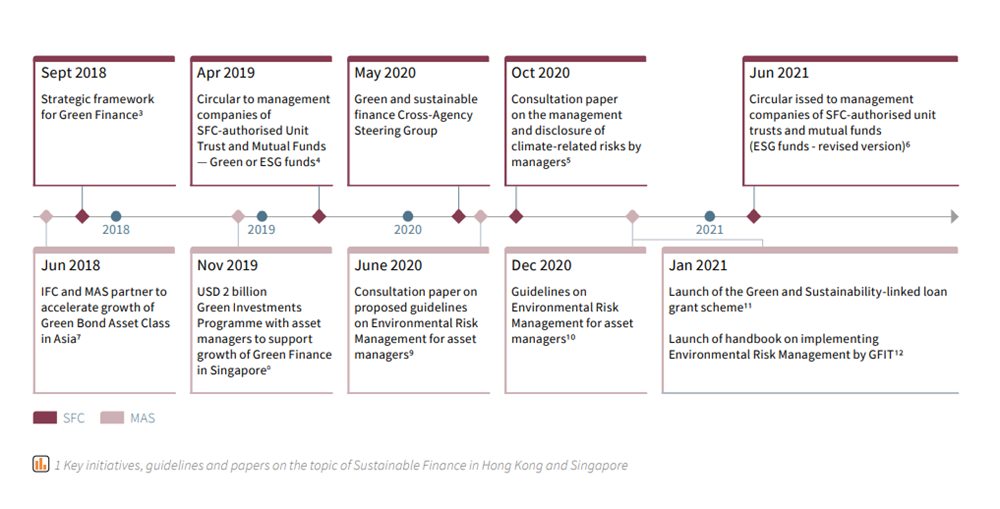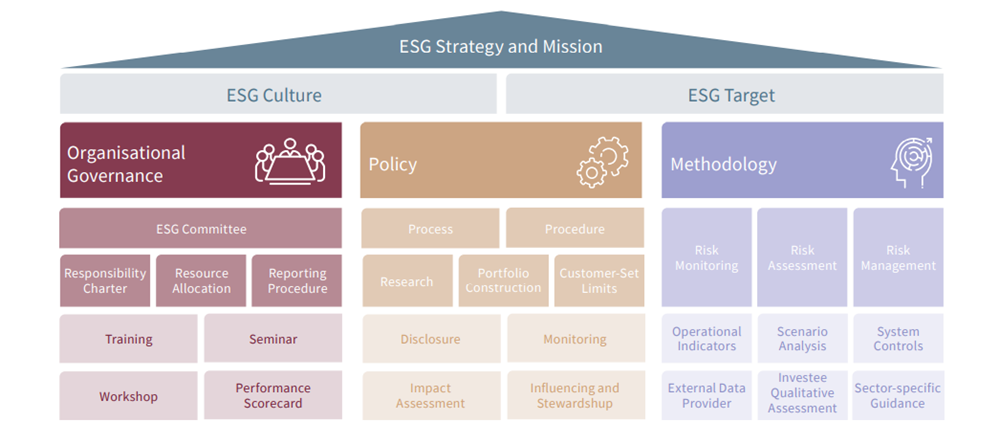Environmental, Social and Corporate Governance (ESG) is becoming a hot topic across the board, and this is especially so within the Asset Management industry with many CEOs of Asset Management firms shifting to a more proactive stance in the last five years, leading topics such as gender diversity and introducing better ESG practices1. In the Global Sustainable Fund Flows Review2, Morningstar reported a record USD 5 billion inflow to sustainable funds for Asia, excluding Japan, in the fourth quarter of 2020, reaching USD 25.4 billion Asset under Management (AuM) mark by end-2020, a 131% year-on-year increase.
In the Global Sustainable Fund Flows Review,2 Morningstar reported a record of USD 5 billion inflow to sustainable funds for Asia, excluding Japan, in the fourth quarter of 2020, reaching the USD 25.4 billion asset under management (AUM) mark by end of 2020, a 131% year-on-year increase.
With the increasing attention paid to ESG concerns, it has become a focal point for regulators in Asia. More recently, the Monetary Authority of Singapore (MAS) and the Hong Kong Securities and Futures Commission (SFC) have published guidelines and consultation papers to provide guidance around risk management, assessment, stewardship, and disclosures.
Background
Hong Kong
In its efforts to build and accelerate the growth of Hong Kong as a hub for green and sustainable finance within the Asia-Pacific region, while supporting the government’s climate strategies, the SFC has been looking into ESG since 2018, and it has progressively introduced initiatives to promote sustainable investing (see Figure 1).3,4
In October 2020, the SFC proposed to amend the Fund Manager Code of Conduct (FMCC), requiring fund managers to consider climate-related risks in their investment and risk management processes and make appropriate disclosures to investors.5 It also plans to issue a circular, setting out the baseline requirements and enhanced standards for larger fund managers.
Some of the key amendments proposed by the SFC include:
- The Board of Directors and senior management to maintain effective oversight over environmental investment and risk management processes and controls.
- Consider and assess the impact of material physical and transition climate-related risks in the investment management process and on the underlying investments’ performance.
- Consider material climate-related risks in the risk management process with effective systems, policies, and procedures, and adopt appropriate tools and metrics to assess climate-related risks.
- Adopt an information disclosure approach that is proportionate to the degree of climate-related risks considered in the investment and risk management processes.
In June 2021, the SFC revised the 2019 Circular to enhance the disclosure and reporting for ESG funds, and provided additional guidance for funds with climate-related focus.6 This circular will take effect and supersede the 2019 Circular from 1 January 2022. The new circular provides extra additional disclosure requirements for the ESG fund regarding both offering documents and additional information on websites.
The key takeaways include:
- The ESG fund should disclose the ESG focus, specific ESG methodology for investment strategy, asset allocation, ESG benchmark details, etc.
- Periodic assessment and reporting on the fund are to be conducted at least once every year.
Singapore
In Singapore, the MAS published "Guidelines on Environmental Risk Management for Asset Managers" in December 2020. It features MAS’ expectations for asset managers and related institutions, setting out sound environmental risk management practices for them to adopt.
The key guidelines include:
- The Board of Directors and senior management to set the tone and articulate the asset manager’s approach to strategies, business plans, and products for environmental risk management, with a clear allocation of responsibilities and effective oversight.
- Evaluate the potential impact of material environmental risk on an investment’s return potential during portfolio construction and ongoing monitoring by measuring and managing material environmental risk factors on the individual investment and portfolio levels.
- Exercise sound stewardship to help shape positive corporate behaviour and manage environmental risk associated with investee companies, as well as support investee companies’ efforts in the transition towards more sustainable business practices.
- Perform meaningful disclosures of asset managers’ environmental risk information and review the disclosures regularly.
While there are no enforcement actions for a failure to comply with the ESG requirements in the past, market participants will need to be vigilant, as this will be an area of increasing regulatory focus in the future.

Challenges for incorporating ESG in asset management
Unlike Europe, where ESG has been rapidly growing in the past decade, ESG is still a relatively new topic in APAC, and challenges may exist in its implementation process due to a lack of relevant experience and expertise. These include:
Lack of concrete standards for distinct asset managers
Regulators have recommended asset managers adopt customised standards on ESG risk exposure and mitigation based on their distinct size, nature of the activity, and risk profile. As each asset manager has a different scale, scope, and business model, there is no one-fit-all standard. Therefore, it is challenging to decide on customised standards based on asset managers’ circumstances.
Challenges in measuring risk exposure and assessing impacts
As a typical asset manager invests in multiple distinct asset classes, industries, and geographies, there can be numerous ESG considerations that depend on the different underlying product issuers. Thus, complex and costly calculation methodologies are required to account for the numerous factors in risk measurement and impact assessment. These approaches will require more time to implement, owing to asset managers having limited prior experience.
Difficulty in implementing system controls
Asset managers are required to monitor environmental risk exposures at both the customer and portfolio levels. In order to implement systematic controls embedded in the asset manager’s system as required by authorities, a thorough assessment is necessary to mitigate exposure to environmental-related risks as well. It will require substantial resources and tools to ensure that the ESG strategies are integrated across various platforms.
Inconsistency in sustainability concept definitions
There is a lack of consistency in defining sustainability amongst asset owners, jurisdictions, professional or industry standards-setting bodies, and within the business sector. As such, it is difficult to determine the data points required to set comparable targets, monitor investments, and compare peer performance.
Varying quality of disclosure
While most funds have named green or ESG factors in their investment objective or strategy, many do not specifically disclose how the management companies incorporate these factors in their investment selection process.
A robust firm-wide ESG framework is paramount to ensure that ESG practices comply with investor and regulatory expectations. Synpulse can support you in building and implementing the ESG framework that is tailored to your specific operational circumstances and nature of business.
Below is an illustration of the ESG framework that is expected by regulators in Singapore and Hong Kong:

Regulatory expectations: ESG framework
Phase I – Gap assessment
An assessment of the maturity of the adoption of the environmental risk framework is performed based on the overall ESG strategy and mission of the Asset Management Institution, with regulatory expectations as a baseline. Focused group workshops and the institution’s existing policies and procedural documentation will be used for the diagnosis to understand the current status in comparison to the target position in terms of governance, policies, and methodology.
This assessment will identify any existing gaps in the regulatory expectation on governance and strategy, risk management, and disclosure. Analysis and recommended environmental risk framework for Phase II is delivered at the end of Phase I.
Phase II – Development of Environmental Risk framework
An environmental risk framework is designed and customised to manage and govern environmental risk. According to the institution’s specific size, nature of business, complexity of operations, and international ESG circumstances, a customised framework will be designed in line with regulatory expectations and industry best practices. Standards for appropriate ESG risk exposure, assessment, mitigation, stewardship and frequency, and extent of ESG disclosure will be clearly defined.
Phase III – Vendor analysis and shortlisting
Phase III supports asset managers in the analysis and shortlisting of all relevant vendors regarding the ESG methodology segments. Based on the institution’s ESG framework, Synpulse provides support in identifying appropriate vendors covering risk monitoring, risk assessment, and risk management aspects. The tools will include, but are not limited to, operational indicators, external data providers, scenario analysis tools for risk assessment, and other system control tools.
When the potential vendors are shortlisted, validation workshops will be conducted with both business and IT stakeholders, with a comparison framework to highlight the benefits and costs for each vendor in order to select the best fit-for-purpose vendor. The key deliverable for this phase will be an Implementation Roadmap detailing the relevant vendors, changes to implement, detailed timelines, and complexity of implementation.
Phase IV – Implementation
Phase IV formalises the Transformation Plan and Implementation Roadmap together with the relevant stakeholders from senior management, business, compliance, risk management, and operations. It identifies resources for the work streams covering governance, policy, and methodology. These workstreams will be carried out in parallel to implement relevant charters, procedural documents, risk measurement and mitigation tools, disclosure requirements, and system controls.
To effectively implement an environmental risk framework, the entire implementation should be overseen by the Board and senior management, so that it brings across a clear direction for employees to align with.
Why work with us
Subject matter expertise
Synpulse is at the forefront of transformation topics and engaging leading financial institutions to deliver both compliant and commercially viable ESG framework in response to the evolving regulations. Our expertise in regulatory compliance and ESG topic will support you in all aspects, as the new ESG regulation comes into focus, providing you with insights and implementation approaches.
Extensive industry experience in the APAC market
Since 2008, Synpulse has worked with many regional and global financial institutions on an array of successful projects across APAC. We understand the most pressing regulatory challenges faced by the industry based on our extensive experience.
Access to global ecosystem partners
Synpulse works closely with innovative ecosystem partners across a wide spectrum of topics. Our extensive network of partners coupled with deep experience and knowledge of the ESG landscape provides us with insights to identify the most suitable technological solution to meet your needs.
Speak to us to find out more about the industry best practices and how these ESG topics may impact your organisation.
1 Top 10 ESG Trends for the new decade (Harvard Law School, March 2020).
2 Global Sustainable Fund Flows: Q4 2020 in Review (Morningstar, January 2021).
3 Strategic Framework for Green Finance (SFC, 21 September 2018).
4 Circular to management companies of SFC-authorized unit trusts and mutual funds — Green or ESG funds (SFC, 11 April 2019).
5 Consultation Paper on the Management and Disclosure of Climate-related Risks by Fund Managers (SFC, October 2020).
6 Circular to management companies of SFC-authorised unit trusts and mutual funds — ESG funds (SFC, 29 June 2021).
7 IFC and MAS Partner to Accelerate Growth of Green Bond Asset Class in Asia (MAS, June 2018).
8 New US$2 billion Investments Programme to Support Growth of Green Finance in Singapore (MAS, November 2019).
9 Consultation Paper on Proposed Guidelines on Environmental Risk Management for Asset Managers (MAS, June 2020).
10 Guidelines on Environmental Risk Management for Asset Managers (MAS, December 2020).
11 Launch of World's First Grant Scheme to Support Green and Sustainability-Linked Loans (MAS, November 2020).
12 Handbook on Implementing Environmental Risk Management (ABS, January 2021).


